Keywords |
| Braincomputer interface; Classification; Electroencephalography; Feature extraction; Fast Fourier
transform; k-nearest neighbor algorithm |
Introduction |
| A brain-computer interface (BCI) obtains a straight connection
pathway between the brain of a physically disabled patient and
an external device or computer. The first aim of BCI research
is to create a non-muscular way for physically disabled patients
to communicate with and control an external device such as a
spelling system for speech or writing a letter. In the past few
decades, BCI systems have been rapidly developed, because
they may be the only possible way of communication for
people who are unable to communicate via conventional means
because of severe motor disabilities. Electroencephalography
(EEG) signals in the field of biomedical engineering are often
used in BCI systems. |
| Although BCI development is a very young research area, in
the literature, many methods based on BCI have been
proposed. In a recent study, researchers used EEG to control an
electronic device [1]. This paper presented the classification of
a three-class mental task-based brain–computer interface (BCI)
that used the Hilbert–Huang transform for the feature extractor
and fuzzy particle swarm optimization by cross-mutated-based
artificial neural network for the classifier. These three relevant
mental tasks for wheelchair control were letter composing,
arithmetic, and Rubik's cube rolling forward that meant left,
right, and forward commands to wheelchair, respectively. The
monitoring of eye movement could help patients communicate with their environment and control devices. A number of
techniques have been used to discern eye movements [2-4]. In
a recent research, Abdelkader et al. proposed a simple
algorithm for the offline recognition of four directions of eye
movement from electroencephalographic signals [5]. A
strategy without a prior model was used to distinguish the four
cardinal directions and a single trial was used to make a
decision. The proposed algorithm in this paper was efficient in
the classification phase with the obtained accuracy of 50-85%
for twenty subjects. Oddball paradigms were used in BCI to
generate event-related potentials (ERPs), like the P300 wave,
on the targets selected by the user. A P300 speller was based
on this principle, in which the detection of P300 waves allowed
the user to write characters. A new method for the detection of
P300 waves was presented by Hubert et al. [6], which was
based on a convolutional neural network (CNN). The topology
of the method was adapted to the detection of P300 waves in
the time domain. Bin He et al. developed a sensorimotor
rhythm EEG-based BCI and aimed to improve BCI systems by
inversely mapping scalp-recorded EEG signals to the cortical
source domain, integrate BCI with noninvasive
neuromodulation strategies to improve learning, and
incorporate mind-body awareness training to enhance BCI
learning and performance [7]. Given these issues, the end goal
had still not reached by these algorithms. There is much work
to be done to produce real-world-worthy systems that can be
comfortably, conveniently, and reliably used by individuals. On the other side, many of these methods are computationally
complex and the classification accuracy measured using EEG
is only between 50% and 80%. |
| In this paper, a new fast and simple brain-computer interface
system based on the gaze on rotating vane-dependent EEG
signals was presented. Speed and simplicity in BCI systems are
very important factors. This study is a beginning step to design
and implement a new, fast, simple, and accurate BCI system.
The proposed method can be used for a biomedical engineering
application to control an electronic device, like an electronic
wheelchair, a robotic arm, etc. Clinically, physicians could
become aware of the subject's state using this method. |
| The organization of this paper is as follows: after the
introduction section, the experimental setup is provided. Then,
feature extraction and classification are described, respectively.
In the fifth section, the results are provided. The conclusion
and discussions are given in the sixth section. |
Experimental Setup |
| EEG signals were obtained from 8 healthy human subjects (5
males and 3 females) in the age groups between 25 and 32
years old at Department of Electrical and Electronics
Engineering, Karadeniz Technical University. Figure 1 shows
the experiment framework and tools. All the subjects reported
normal or corrected-to-normal vision. Before beginning to
record, the subjects were asked to calm down and relax in a
chair for 5 min. The chair was placed 1 m in front of the
monitor, as shown in Figure 1. Using Matlab 2014a, a red
rotating vane in a black screen was designed. In the center of
the screen, the letter of ‘A’ was written in white. The vane
rotated on the letter of ‘A’. Speed and direction of the rotation
could be controlled. Two rotation speeds were defined: one
rotation per 5 sec (called slow rotating) and one rotation per 1
sec (called fast rotating). Screenshot of the rotating vane is
shown in Figure 2. |
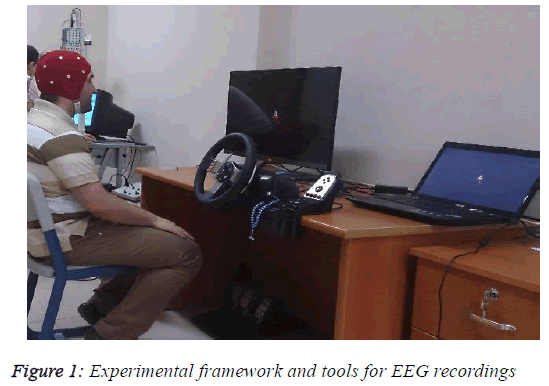 |
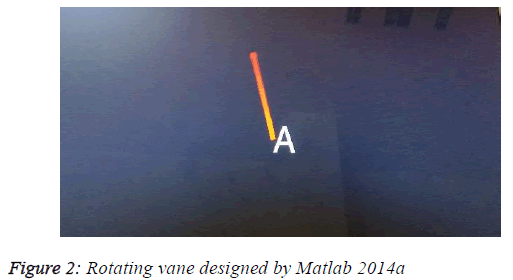 |
| In this study, the EEG signals were acquired by Brain Quick
EEG System (Micromed, Italy). The EEG signals were
sampled at 512 Hz and filtered between 0.1 and 120 Hz. To
eliminate line noise, a 50 Hz notch filter was used. The
electrodes were used on the scalp in different locations based
on the international 10-20 system. Twelve EEG electrodes
from all lobes of the brain were located according to this
system as shown in Figure 3 and referenced to the electrode
Cz. These electrodes included Fp1, Fp2, F7, F3, F4, C3, C4,
T3, T4, P3, P4, and O1. EEG recording was in three sessions.
In the first session, each subject gazed at the clockwise rotating
vane at slow speed for 4 min. There was a 2-min gap for
relaxation. Afterwards, the subject was asked to gaze the anticlockwise
rotating vane at fast speed for 4 min and, after 2 min
of relaxation, in the third session, the subject gazed at the anticlockwise
rotating vane at slow speed for 4 min. To
synchronize, the subject received a beep sound and, at the same
time, the vane began to rotate. In these three sessions, the
generated signals (separately for each channel) were divided
into 1 sec epochs. In this way, 240*3 epochs (240 epochs for
each speed) were generated per subject. Epochs of each session
were divided into two groups. The first group was called
training set (which contained 120 epochs) and the second
group was called testing set (which contained 120 epochs).
Also, the proposed method was tested on 2-sec, 3-sec, and 4-
sec epochs. Collection of the data set is described in Table 1. |
Feature Extraction |
| Fast fourier transform (FFT) |
| The Fourier transform is a method to convert time domain
signals into frequency domain that is defined as Equation 1.
Discrete Fourier Transform (DFT) converts discrete-time
sequences into discrete-frequency versions, which is derived
by Equation 2. DFT of discrete-time signals and is widely used
for spectrum analysis. |
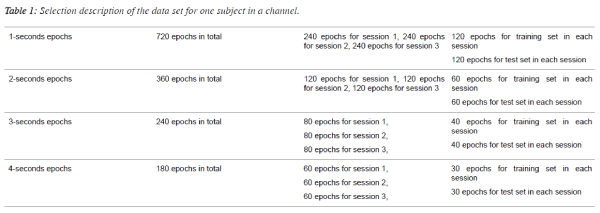 |
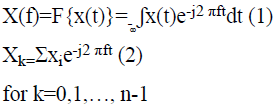 |
| where in Equation 1, x(t) is the time domain signal and X(f) is
its Fourier Transform; in Equation 2, x is the input sequence, X
is its DFT, and n is the number of samples [8]. The FFT is an
optimized implementation of a DFT, because DFT is
computationally very intensive in theory [9]. |
| In this study, the generated epochs were used for extracting
features. As is known, there are 5 frequency rhythms in EEG
signals: delta-band (0-4 Hz with 75 micro volt _Amplitude),
theta-band (4-7 Hz with 50_75 micro volt _Amplitude), alphaband
(8-12 Hz with 20_60 micro volt _ Amplitude), beta-band
(13-49 Hz with 2_20 micro volt_ Amplitude), and gammaband
(30-49 Hz with 20_60 micro volt _ Amplitude) [10].
These bands were extracted by fast Fourier transform (FFT)
method. In this paper, we used fft( ) function in Matlab for the
detection of EEG signal bands. Mean of absolute power of FFT
in each epoch was used as features. In this way, for each epoch
in one channel, 5 features were extracted and, as mentioned, 12
channels were used. So, 60 (12*5) features were prepared for
each epoch. |
Classification procedure |
| An algorithm that has to be trained with labelled training
samples to be able to distinguish new unlabelled samples
between a fixed set of classes is called a classifier. In this
study, k-NN algorithm was used to classify the extracted
features from EEG signals. A summary of this algorithm is
given below: |
k-NN Algorithm |
| k-NN is one of the easiest algorithms for implementation among the existing classification algorithms. First, in this algorithm, the number of the nearest neighbour to the unknown
sample must be determined. Euclidean distance method is
commonly used to calculate the nearest neighbours to the
sample. Then, the label that is maximum between these
neighbours is diagnosed and the unknown sample is labelled
with its maximum label. In binary classification problems, it is
beneficial to use odd numbers for k, because they do not cause
any problems for researchers while deciding upon a label [10]. |
| In this study, to determine optimum k value, K-fold cross
validation (K-FCV) technique was used. Minimum number of
epochs in the training set for each speed was 40 (for 4-sec
epochs); so, the optimum k value was searched in the interval
between 1 and 39 with the step size of 2. |
Results |
| In this paper, we classified the pairwise of three sessions (as
mentioned above). For each subject, we separately trained k-
NN classifier. To verify the results, classification was repeated
10 times in each data set with different distributions of training
and testing sets. The classification result (CR) was defined as
the percentage of the number of epochs classified correctly
over the size of the testing set. Mean of the classification
results and standard deviations for 1-sec, 2-sec, 3-sec, and 4-
sec epochs, when vane rotated fast and when it rotated slow in
clockwise way, are provided as Table 2. Table 3 shows the
classification results when vane rotated fast and slow in anticlockwise
way. Finally, the result of classification, when vane
rotated slow in clockwise and slow in anti-clockwise ways, are
presented in Table 4. |
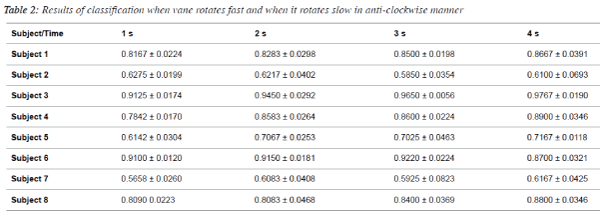 |
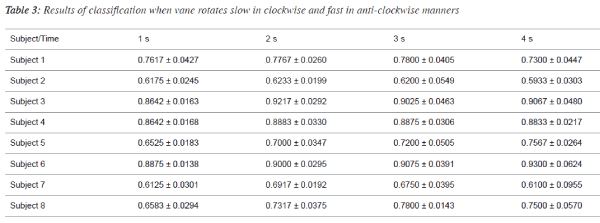 |
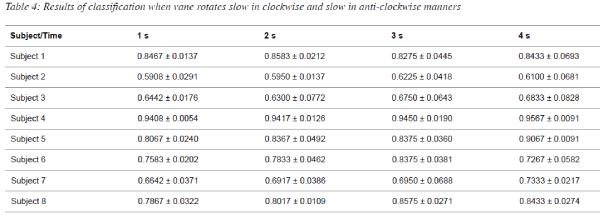 |
Conclusion and Discussion |
| BCI is a kind of communication system that enables the control
of devices or communication with others only through the
brain's signal activities without using motor activities. This
paper presented a novel approach for brain-computer interface
systems. A simple algorithm was developed for the offline
identification of rotating vane from EEG signals without any
training phase. The results of this paper showed that EEG
signals in during gaze on the vane with different speeds and
directions have significant information. The proposed
algorithm was promising for real-time applications. |
| In the future, we would like to design a suitable BCI system
based on rotating vanes. Reduction channels to make the user
more comfortable and using different methods for feature
extraction and classification will be pursued in our future
works. The goal is non-invasive, asynchronous, fast, and
simple BCI system based on EEG, because a BCI system with
these properties is very suitable for practical machine control,
inexpensive, and potentially portable. We hope the proposed
algorithm could be used for the real-time control of an
electronic device, a wheelchair, or a robotic arm. |
References |
- R Chai, SH Ling, P Hunter, Y Tran, Nguyen HT. Brain-Computer Interface Classifier for Wheelchair Commands Using Neural Network With Fuzzy Particle Swarm Optimization, IEEE Journal Of Biomedical And Health Informatıcs 2014; 18: 5.
- Q Ji, H Wechsler, AT Duchowski, M Flickner. Special issue: eye detection and tracking. Comput Vis Image Underst 2005; 98: 1-3.
- SKawato, N Tetsutani. Detection and tracking of eyes for gaze-camera control. Image Vis Comput 2004; 22: 1031-1038.
- J Kim. A simple pupil-independent method for recording eye movements in rodents using video J Neurosci Methods 2004; 138: 165-171.
- N Abdelkader H Hideaki, Y Natsue, S Duk, K Yasuharu. Classification of Four Eye Directions from EEG Signals for Eye-Movement-Based Communication Systems. Journal of Medical and Biological Engineering 2014.
- C Hubert, G Axel. Convolutional Neural Networks for P300 Detection with Application to Brain-Computer Interfaces. IEEE Transactions on Pattern Analysıs and Machine Intelligence 2011; 33: 3.
- B He, B Baxter, BJ Edelman, Ch C Cline, Ye WW. Noninvasive Brain-Computer Interfaces Based on Sensorimotor Rhythms. Proceedings of the IEEE 2015; 103: 6.
- Oppenheim AV, Schafer RW. Discrete-Time Signal Processing, Prentice-Hall, 1989; p. 611-619.
- CS Burrus, TW Perks. DFT/FFT and Convolution Algorithms. Wiley Interscience, New York, 1985.
- Temel K, Masoud M, Kubra E. Fast and accurate PLS-based classification of EEG sleep using single channel data. Expert Systems with Applications 2015; 42: 7825-7830.
|






